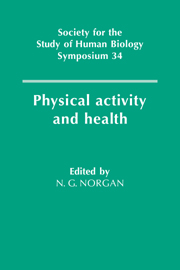Book contents
- Frontmatter
- Contents
- List of contributors
- Acknowledgements
- 1 Introduction
- 2 Comparative aspects of human activity
- 3 Physical activity levels – past and present
- 4 The validity of health measurements
- 5 Developments in the assessment of physical activity
- 6 Two national surveys of activity, fitness and health: the Allied Dunbar National Fitness survey and the Welsh Heart Health survey
- 7 Physical development and childhood activity
- 8 Physical activity and behavioural development during childhood and youth
- 9 Physiological aspects of activity and ageing
- 10 Activity and morale in later life: preliminary analysis from the Nottingham Longitudinal Study of Activity and Ageing
- 11 The benefits of low intensity exercise
- 12 Physical activity, obesity and weight maintenance
- 13 Adherence to physical activity and exercise
- 14 Women's working behaviour and maternal-child health in rural Nepal
- 15 Physical activity and psychological well-being
- 16 Leisure lifestyles: present and future
- Index
8 - Physical activity and behavioural development during childhood and youth
Published online by Cambridge University Press: 05 December 2011
- Frontmatter
- Contents
- List of contributors
- Acknowledgements
- 1 Introduction
- 2 Comparative aspects of human activity
- 3 Physical activity levels – past and present
- 4 The validity of health measurements
- 5 Developments in the assessment of physical activity
- 6 Two national surveys of activity, fitness and health: the Allied Dunbar National Fitness survey and the Welsh Heart Health survey
- 7 Physical development and childhood activity
- 8 Physical activity and behavioural development during childhood and youth
- 9 Physiological aspects of activity and ageing
- 10 Activity and morale in later life: preliminary analysis from the Nottingham Longitudinal Study of Activity and Ageing
- 11 The benefits of low intensity exercise
- 12 Physical activity, obesity and weight maintenance
- 13 Adherence to physical activity and exercise
- 14 Women's working behaviour and maternal-child health in rural Nepal
- 15 Physical activity and psychological well-being
- 16 Leisure lifestyles: present and future
- Index
Summary
The developmental tasks of children and youth are many. Their successful attainment is related in part to the child's growth, maturation and development, and to numerous factors in the child's environments. One of the major tasks of childhood and youth is the development of competence in a variety of behavioural domains. Although many factors are involved in the development of behavioural competence, physical activity is often viewed as having a favourable influence. The role of physical activity in the development of several aspects of behavioural competence during childhood and youth is the focus of this chapter.
Growth, maturation and development
The terms growth, maturation and development often have different meanings to professionals involved with children and youth. Suggested domains of each are outlined in Table 8.1. Growth refers to changes in size, physique and body composition, and in various systems of the body, many of which are related to growth in body size, e.g. the cardiovascular and respiratory systems.
Maturation refers to the rate of progress towards the mature state. When dealing with behaviour, maturation is most often viewed in the context of sexual and somatic maturation during adolescence. Individuals attain skeletal, sexual and somatic maturity, but do so at varying rates. The neuromuscular domain is an additional indicator of maturity, particularly in infancy and early childhood. Early motor development and level of proficiency in fundamental movement tasks may serve as an indicator of neuromuscular maturation.
- Type
- Chapter
- Information
- Physical Activity and Health , pp. 101 - 120Publisher: Cambridge University PressPrint publication year: 1992
- 1
- Cited by



